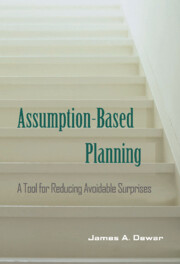Book contents
- Frontmatter
- Contents
- Figures
- Preface
- Acknowledgments
- 1 The essence of Assumption-Based Planning
- 2 A taxonomy of assumptions
- 3 Step 1: identifying assumptions
- 4 Step 2: identifying load-bearing, vulnerable assumptions
- 5 Step 3: identifying signposts
- 6 Step 4: developing shaping actions
- 7 Step 5: developing hedging actions
- 8 The art of conducting ABP
- 9 Beyond ABP as a post-planning tool
- Appendix: Assumption-Based Planning and the planning literature
- Bibliography
- Glossary
- Index
Preface
Published online by Cambridge University Press: 29 October 2009
- Frontmatter
- Contents
- Figures
- Preface
- Acknowledgments
- 1 The essence of Assumption-Based Planning
- 2 A taxonomy of assumptions
- 3 Step 1: identifying assumptions
- 4 Step 2: identifying load-bearing, vulnerable assumptions
- 5 Step 3: identifying signposts
- 6 Step 4: developing shaping actions
- 7 Step 5: developing hedging actions
- 8 The art of conducting ABP
- 9 Beyond ABP as a post-planning tool
- Appendix: Assumption-Based Planning and the planning literature
- Bibliography
- Glossary
- Index
Summary
Assumption-Based Planning (ABP) started out in 1987 as an approach Morlie Hammer Levin and I developed to solve a U.S. Army strategic planning problem. Thanks to the fall of the Berlin Wall two years later, that early ABP work initiated an ongoing conversation with the Army about how to do planning in the Army's newly and differently uncertain times. The use of ABP was first described in James A. Dewar and Morlie H. Levin, Assumption-Based Planning for Army 21, Santa Monica, Calif.: RAND, R-4172-A, 1992, and ABP itself was first documented in James A. Dewar, Carl H. Builder, William M. Hix, and Morlie H. Levin, Assumption-Based Planning: A Planning Tool for Very Uncertain Times, Santa Monica, Calif.: RAND, MR-114-A, 1993. As ABP evolved through various Army and other applications, it turned into a planning tool—a self-contained process with a specific planning purpose—that is applicable to any kind of plan or planning process. ABP continues to evolve, but its fundamentals have changed little in its last several applications. For that reason, it seemed appropriate to document formally what we have learned about it.
The careful reader will already have noticed that I use both the singular and plural first-person pronouns in talking about ABP. My coauthors on the original ABP documentation were intimately involved in both the intellectual development of ABP and in the learning process that accompanied its application to real planning problems.
- Type
- Chapter
- Information
- Assumption-Based PlanningA Tool for Reducing Avoidable Surprises, pp. xiii - xviPublisher: Cambridge University PressPrint publication year: 2002



